Follow us 148.4k
I love sourdough bread. In fact, it was what I missed most when I gave up grains and sugar, and started following a healthy keto & paleo diet. Making good sourdough bread has been one of the biggest challenges I've faced when adapting traditional all-time favourites so they can be eaten on a ketogenic diet. It took some fine-tuning but I finally got the recipe I wanted.
This bread is not the first sourdough recipe I've created - there is a similar recipe in the KetoDiet app and also in my upcoming cookbook. Both use sightly different ingredients and a different cooking technique. Unlike the traditional sourdough bread, this one doesn't require several days of culturing - it takes just over an hour. To recreate the typical taste of a sourdough bread, I used vinegar and buttermilk. Also, because I used vinegar, I omitted cream of tartar which I use in most of my baked recipes. As I mentioned before, vinegar is a good alternative to cream of tartar when making gluten-free baking powder.
Compared to my other keto bread recipes, I used slightly different temperature and cooking time because these baguettes seemed to be more prone to burning - maybe due to the buttermilk.
Keto Bread Troubleshooting
Lukewarm water in this recipe will slow down the raising effect of baking soda. I tried both boiling water and lukewarm and although it made no difference for baguettes, some people have been experiencing air bubbles / hollow insides when making a loaf. More tips on the perfect loaf are listed here.
Make sure you use a kitchen scale for measuring all the dry ingredients. Using just cups may not be enough to achieve best results, especially in baked goods. Weights per cups and tablespoons may vary depending on the product/brand or if you make you own ingredients (like flaxmeal from flaxseeds). Psyllium absorbs lots of water. When baking with psyllium, you must remember to drink enough water throughout the day to prevent constipation!
Use egg whites. The reason you shouldn't use only whole eggs is that the bread wouldn't rise with so many egg yolks in. Don't waste them - use them for making Homemade Mayo, Easy Hollandaise Sauce or Lemon Curd. For the same reason, use low-fat (not full-fat) buttermilk.
Eliminate moisture. Baked goods that use psyllium always result is slightly moist texture. If needed, cut the baguettes in half and place in a toaster or in the oven before serving.
Do not use whole psyllium husks. Use a coffee grinder or a food processor to powder them first.
I do not recommend ready-made psyllium husk powder. I've baked dozens of keto breads and I made all of them using whole psyllium husks that I powdered myself. Ready-made psyllium husk powder is often too fine and makes any keto bread too dense, flat and heavy. Sometimes the bread would also get a purple hue and an ammonia-like aftertaste (although that may be related to rancid flax meal). Trust me, you don't want any of these in your low-carb bread! The best way to get the best texture and flavour is to buy whole psyllium husks and powder them in a coffee grinder of a food processor.
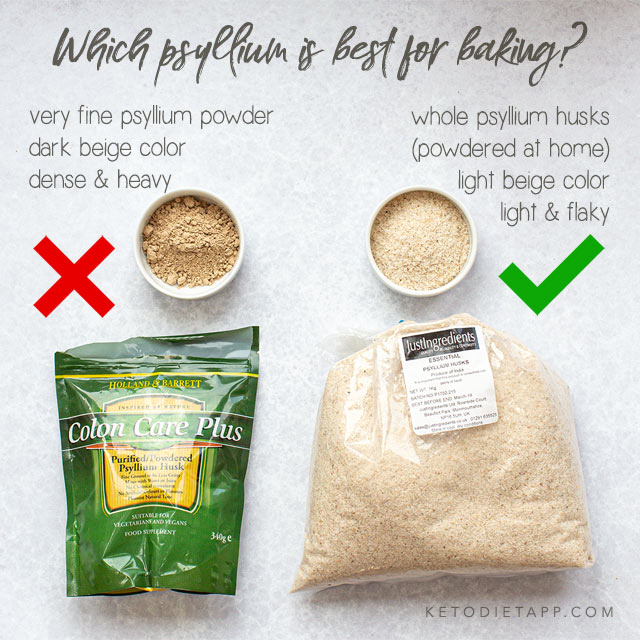 Follow us 148.4k
Follow us 148.4k
Substitutions and Tips
- For more tips on how to make the perfect low-carb loaf, have a look at this post (troubleshooting at the end of the post).
- This dough is based on the these Keto Buns (without the garlic powder, onion powder, sesame seeds and cream of tartar)
- Nut-free keto buns - include flaxmeal and coconut flour.
- Psyllium-free buns - include flaxmeal, almond flour and coconut flour.
- Flax-free, multi-purpose bread, includes coconut flour and a nut-free option.
- If you don't want to use coconut flour: Although I haven't tried it, I'd use twice the amount of almond flour or flaxmeal instead of coconut flour (1 cup of almond flour / flaxmeal instead of 1/2 cup coconut flour). Or you can use the same amount but reduce the water by ~ 1/2 cup.
- For a paleo, dairy-free option, try this coconut milk kefir recipe instead of the buttermilk: Use half of the coconut milk kefir and half water.
Hands-on Overall
Serving size 1 regular baguette
Nutritional values (per serving, 1 regular baguette)
Net carbs4.5 grams
Protein12.2 grams
Fat16.4 grams
Calories232 kcal
Calories from carbs 8%, protein 23%, fat 69%
Total carbs14.1 gramsFiber9.6 gramsSugars2.8 gramsSaturated fat2.7 gramsSodium538 mg(23% RDA)Magnesium100 mg(25% RDA)Potassium360 mg(18% EMR)
Ingredients (makes 8 regular baguettes or 16 mini baguettes)
Dry ingredients:
Wet ingredients:
- 6 large egg whites
- 2 large eggs
- 3/4 cup low-fat buttermilk or kefir (180 g/ 6.5 oz) - or use coconut milk kefir for dairy-free
- 1/4 cup white wine vinegar or apple cider vinegar (60 ml/ 2 fl oz)
- 1 cup lukewarm water (240 ml/ 8 fl oz)
Instructions
- Preheat the oven to 180 °C/ 355 °F (fan assisted), or 200 °C/ 400 °F (conventional). Use a kitchen scale to measure all the ingredients carefully. Mix all the dry ingredients in a bowl (almond flour, coconut flour, ground flaxseed, psyllium powder, baking soda, and salt).
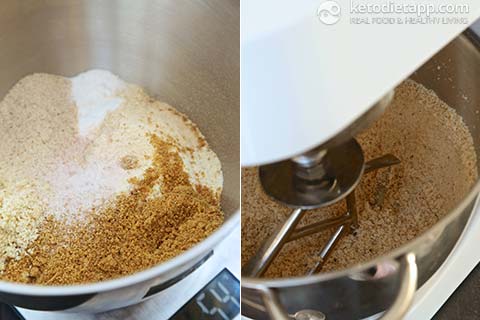
- In a separate bowl, mix the eggs, egg whites and buttermilk (or use coconut milk kefir for dairy-free).

- Add the egg mixture and process well using a mixer until the dough is thick. Add vinegar and lukewarm water and process until well combined.
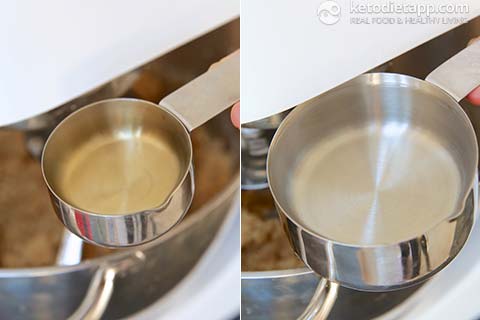
- Do not over-process the dough. Using a spoon, make 8 regular or 16 mini baguettes and place them on a baking tray lined with parchment paper or a non-stick mat. They will rise, so make sure to leave some space between them. Optionally, score the baguettes diagonally and make 3-4 cuts.
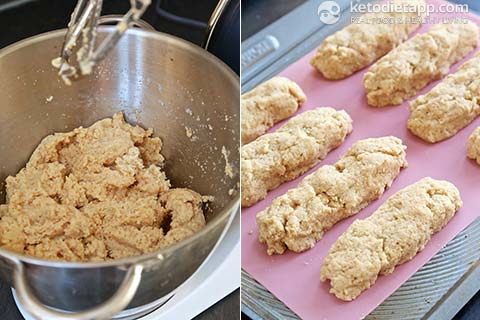
- Place in the oven and cook for 10 minutes. Then, reduce the temperature to 150 °C/ 300 °F (fan assisted), or 170 °C/ 340 °F (conventional) and bake for another 30-45 minutes (small baguettes will take less time to cook).
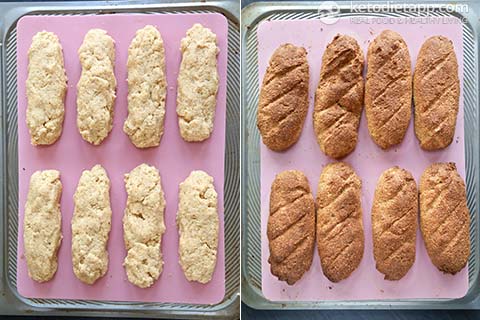
- Remove from the oven, let the tray cool down and place the baguettes on a rack to cool down to room temperature. Store them at room temperature if you plan to use them in the next couple of days or store in the freezer for up to 3 months.
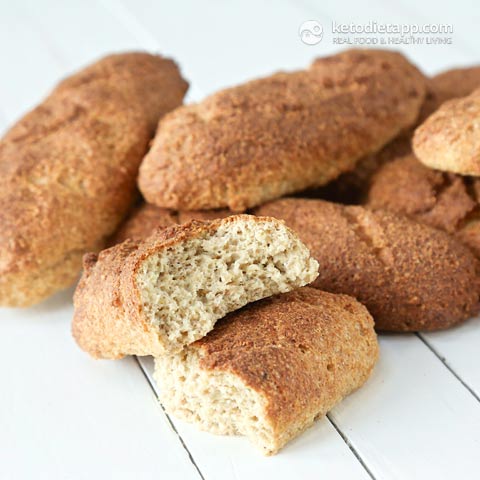
- Enjoy just like regular baguettes! To save time, mix all the dry ingredients ahead and store in a zip-lock bag and add a label with the number of servings. When ready to be baked, just add the wet ingredients.

Ingredient nutritional breakdown (per serving, 1 regular baguette)
| Net carbs | Protein | Fat | Calories |
|---|
| Almond flour (blanched ground almonds, almond meal) |
| 1.6 g | 4 g | 9.8 g | 111 kcal |
| Psyllium husk powder |
| 0.5 g | 0.2 g | 0 g | 3 kcal |
| Coconut flour, organic |
| 0.8 g | 1.3 g | 1.1 g | 28 kcal |
| Flaxmeal (flax meal), ground flaxseed |
| 0.1 g | 1.7 g | 4 g | 50 kcal |
| Baking soda, raising agent (bicarbonate of soda) |
| 0 g | 0 g | 0 g | 0 kcal |
| Salt, pink Himalayan rock salt |
| 0 g | 0 g | 0 g | 0 kcal |
| Egg white, fresh |
| 0.2 g | 2.7 g | 0 g | 13 kcal |
| Egg, whole, fresh, raw (free-range or organic eggs) |
| 0.1 g | 1.6 g | 1.2 g | 18 kcal |
| Milk, buttermilk, fluid, cultured, lowfat |
| 1.1 g | 0.8 g | 0.2 g | 9 kcal |
| Wine vinegar |
| 0 g | 0 g | 0 g | 1 kcal |
| Water, still |
| 0 g | 0 g | 0 g | 0 kcal |
| Total per serving, 1 regular baguette |
| 4.5 g | 12.2 g | 16.4 g | 232 kcal |
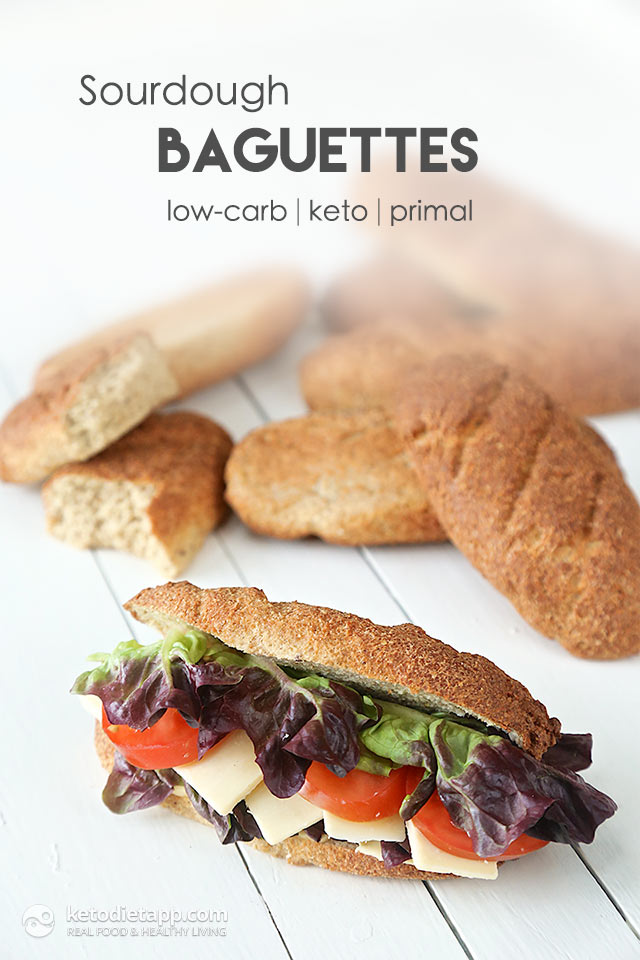 Follow us 148.4k
Follow us 148.4k
Do you like this recipe? Share it with your friends!
Let us know what you think, rate this recipe!
